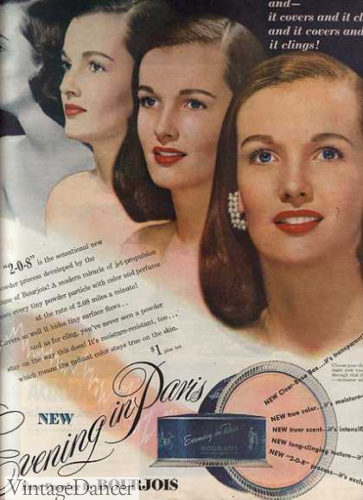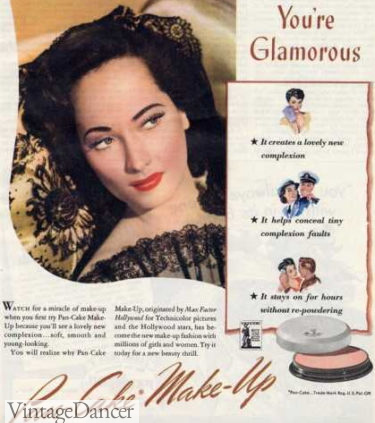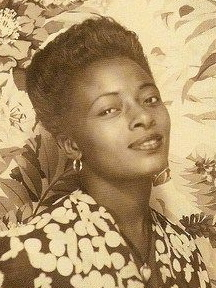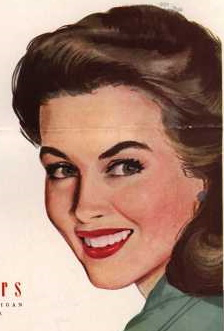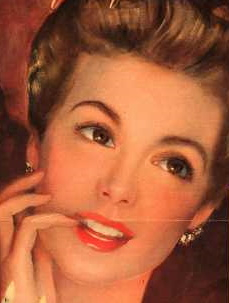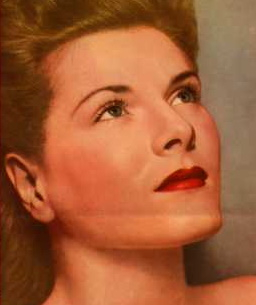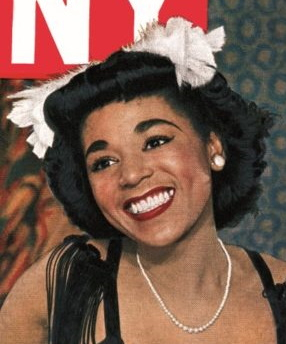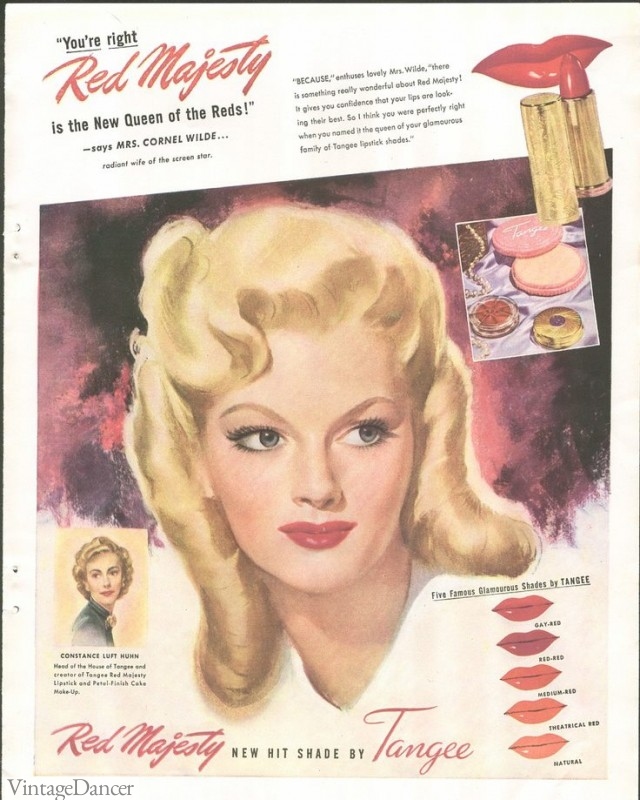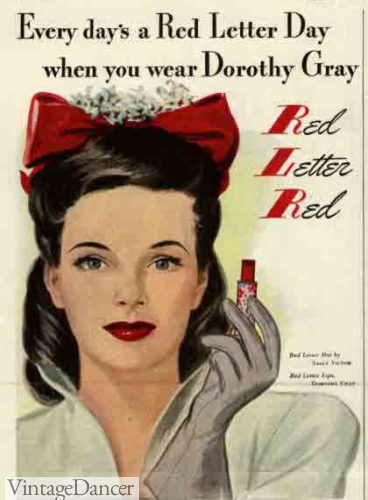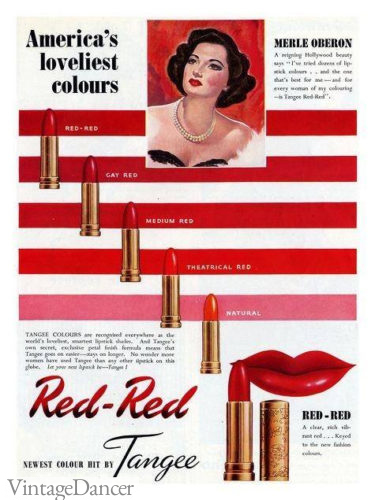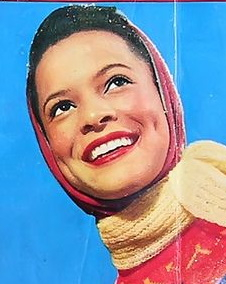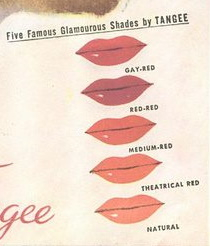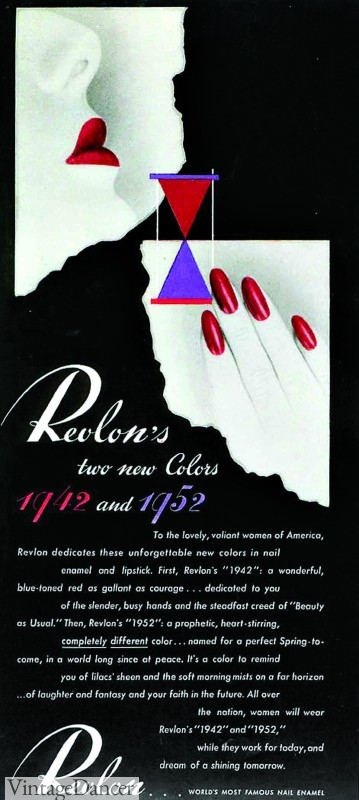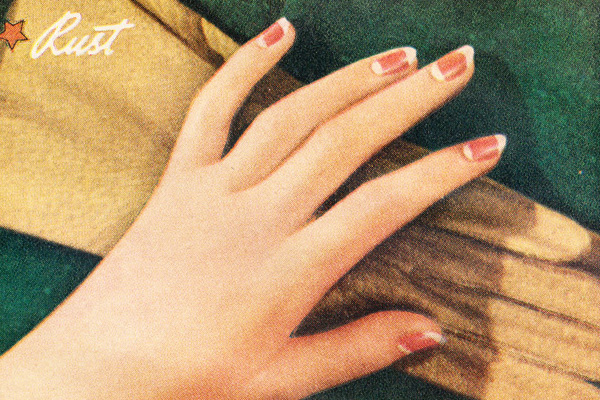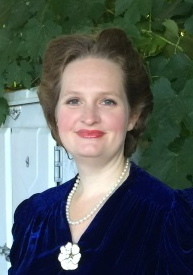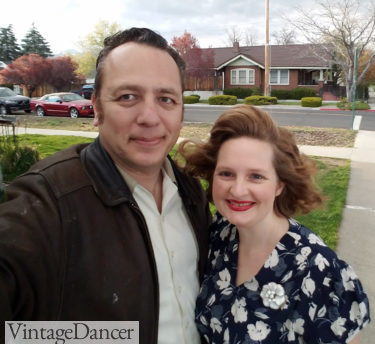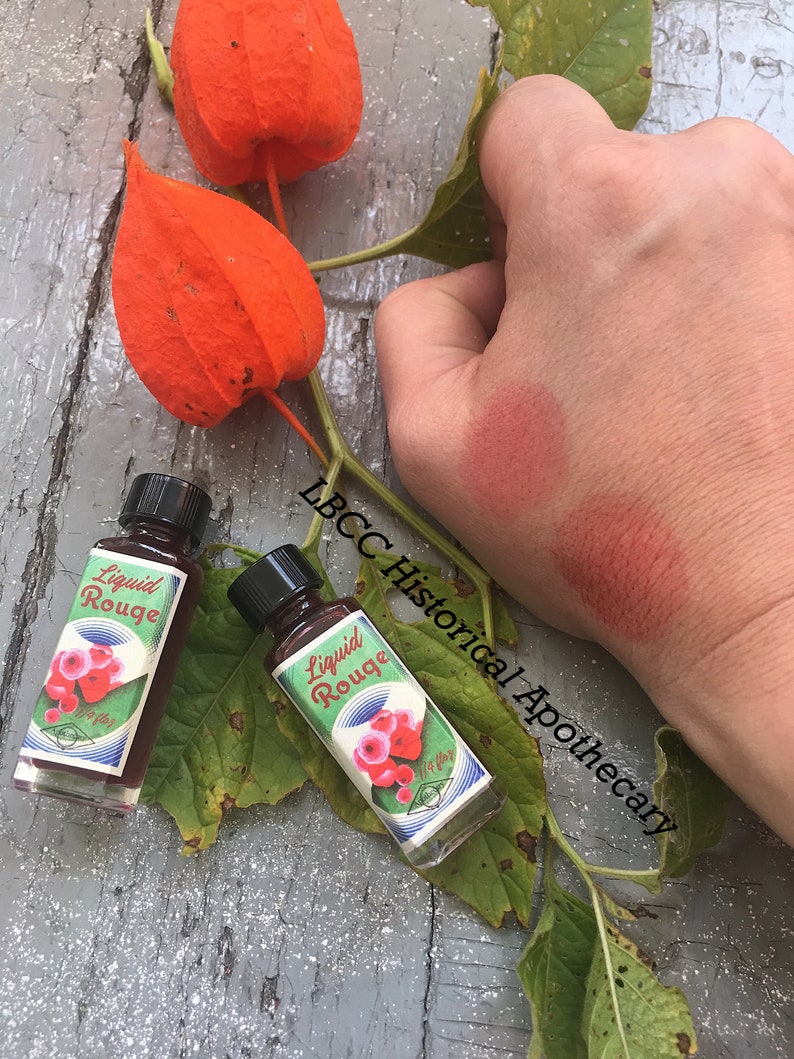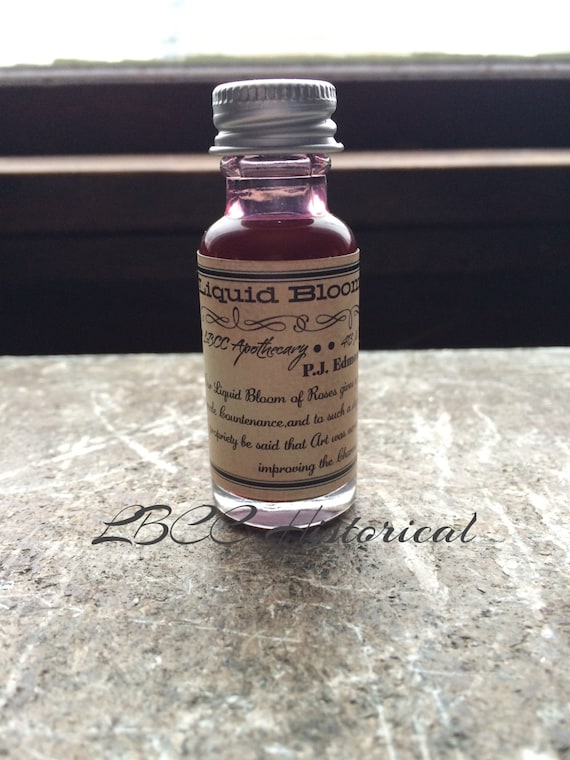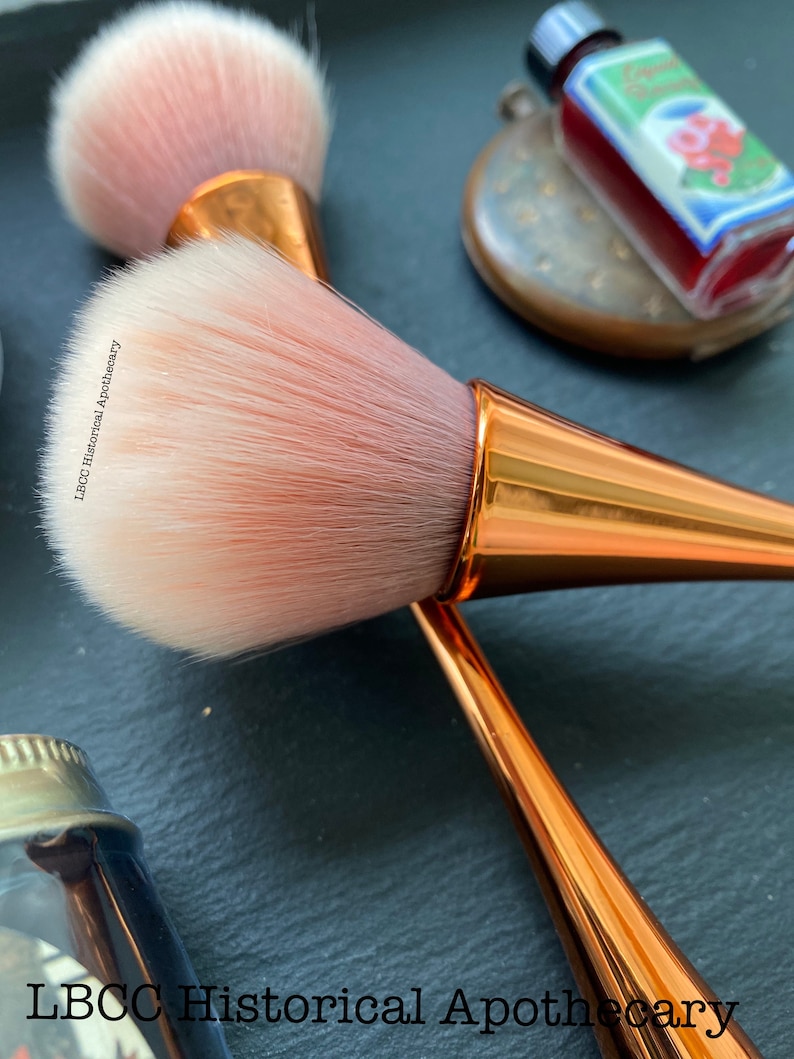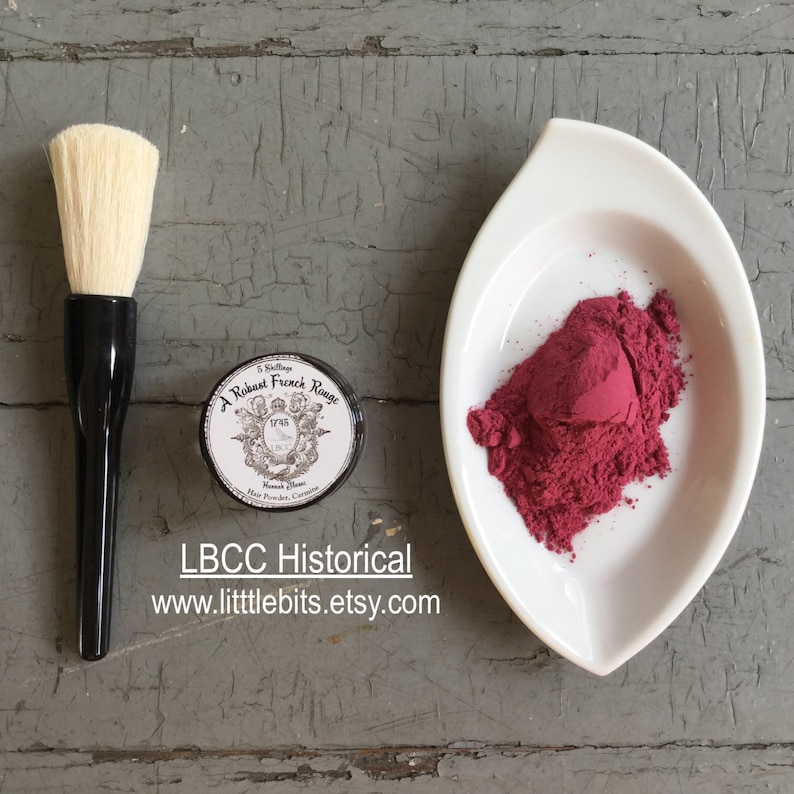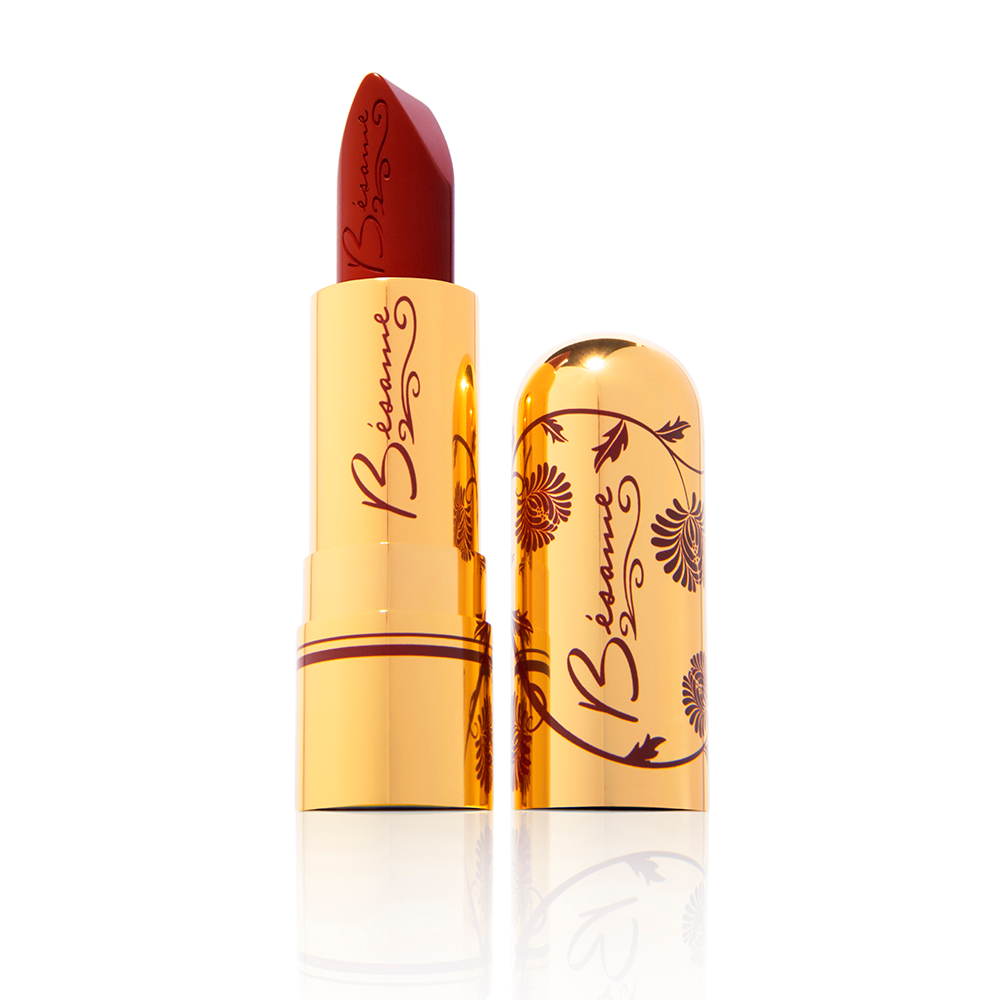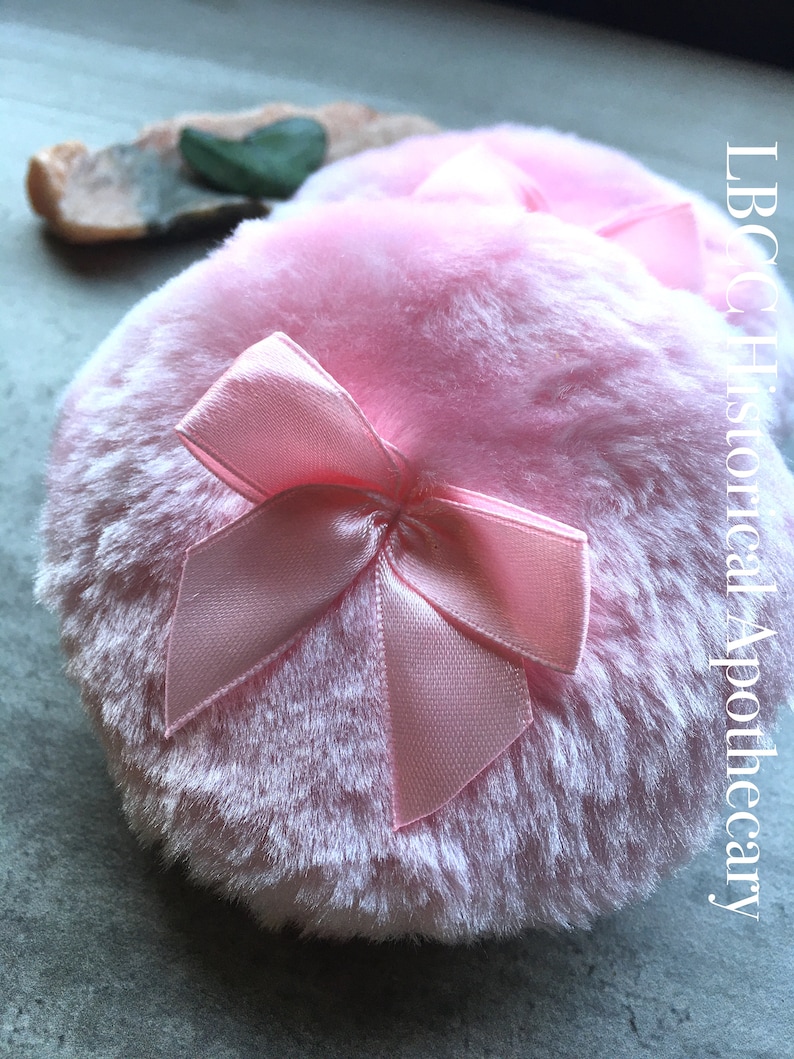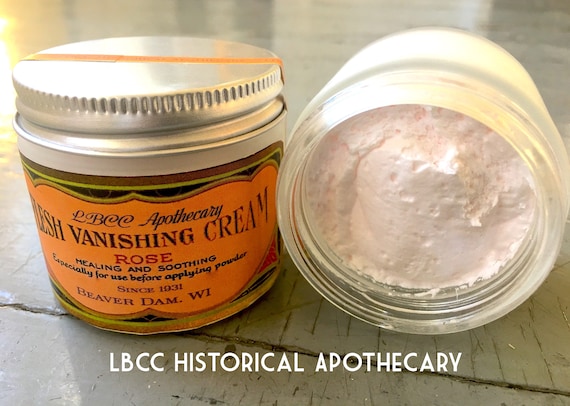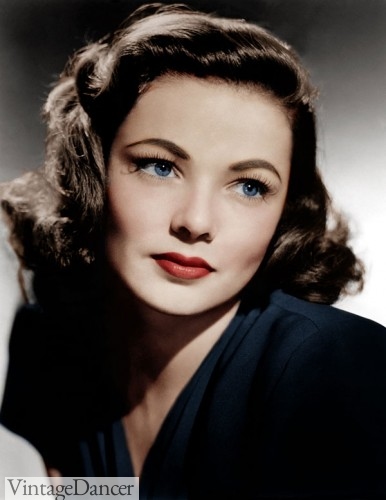
Gene Tierney Wears the 1940s Look with All Natural Ease
1940s makeup is one of the most “vintage” looks, and is rather simple to recreate. There was a push for all things natural, unlike the 1930s and 1950s, which favored reshaping eyebrows and contouring the face. 1940s makeup enhanced natural beauty with just a few tools.
During the war, European women dealt with huge cosmetics shortages, since petroleum and alcohol – some of the main ingredients in makeup at the time – were used for the war effort. When makeup ran out, women turned to home remedies to substitute, such as using beetroot juice to stain lips and petroleum jelly to darken lashes and shape eyebrows.
In the United States, cosmetics continued to be manufactured throughout the war and were seen by the government as a morale booster for the busy women on the home front. Women were encouraged to wear makeup all the time to hide sadness and attract men, even while at work. Athletes even wore makeup. Color films had a big impact on the market, as women could now imitate the shades worn by Hollywood starlets. By 1948, between 80 and 90 percent of women wore lipstick, two thirds wore rouge, and a quarter wore eye makeup.
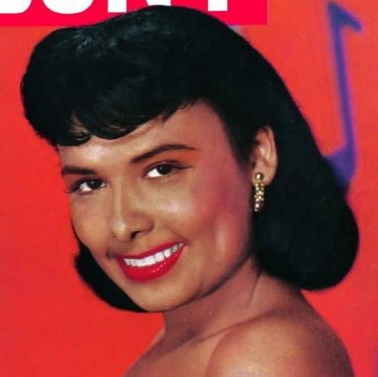
Lena Horne, 1946
The makeup look of the 1940s is classic and sophisticated, but very simple to recreate. Faces were flawless and fresh looking – the look was all-natural, never ‘painted on.’ Less was always better than more, which was good, since most women were surviving on less and less in the early years.
Although this all sounds very simple, a woman’s 1940s makeup routine could take a while – the five minute face did not exist! First, the thick foundation had to be applied and blended. Women were encouraged to shape their face with lighter and darker shades of foundation – a darker shade could be used to ‘fix’ a large nose, big forehead or square jaw. A lighter shade on cheeks could make them look plumper.
Next came the eye shadow. After that, moist rouge was applied. This could also be used to shape the face, but had to look natural. Then powder was applied with a huge velour or wool puff. It had to be pressed into the face and was applied heavily (as in the face would be covered in powder!). Then the excess had to be brushed off the face with a powder brush. If the moist rouge wasn’t enough, a powdered one would be applied over the face powder. Next came the eyebrow pencil, mascara, and (finally!) lipstick was applied.
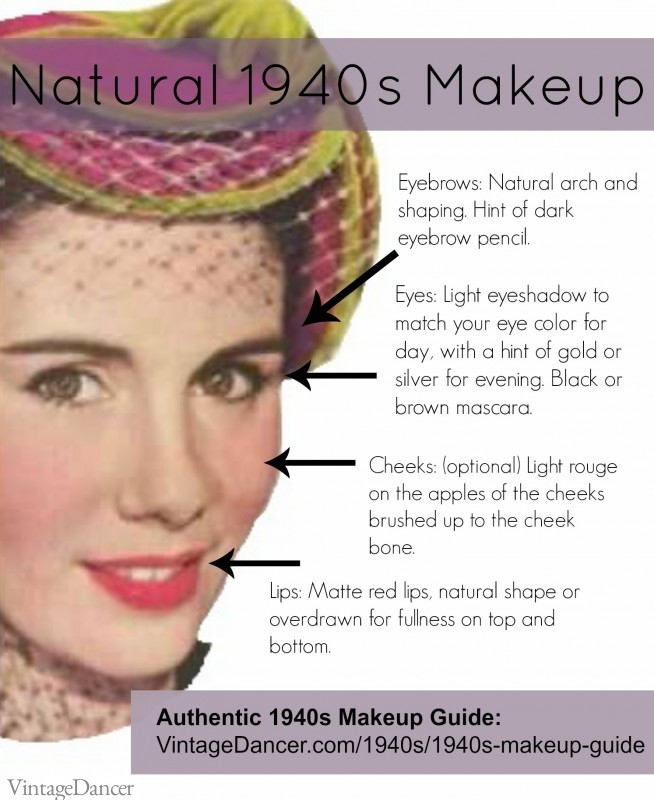
1940s Makeup Plan
What you need:
- Foundation: A similar color to your skin.
- Powder: Loose powder to match your skin.
- Cream Rouge: (not powder, unless that is all you can get) In a rose-pink shade.
- Eyebrow Pencil: Matching or one shade darker than hair color.
- Eye Shadow: (optional, for evenings) match eye color, use a matte finish – no shimmer!
- Mascara: Dark brown or black, or petroleum jelly (Vaseline) only.
- Lipstick: Matte RED lipstick.
1940s Foundation Powder
Foundations weren’t the same as they are today, and not many shades were available–most had a pinkish hue, which worked well for white women but not for ladies of color. Black women often mixed their own makeup or went without powders.
Foundations were also much thicker and creamier – none of our lightweight liquid foundations were around. Face powder was essential and matched the skin tone while keeping the face matte. Foundation was not only used to ‘correct’ a woman’s color, like it had in the past, but it also helped powder to cling to the face (it couldn’t really be used on bare skin without falling off). Foundation and powder were often extended all the way down to the dress or blouse line, since the shade most likely didn’t match the face perfectly, to make it less noticeable.
Tip: Apply a light coat of baby oil (mineral oil) to your face before applying a foundation.
- 1947 Powder
- Pan-Cake Powder
1940s Face Powder
Powders should match your natural skin tone as much as possible. Light shades kept a woman looking fresh and youthful, while a slightly bronzed shade added a sun kissed glow, popular with movie stars. Almost all makeup lines carried a sun kissed color or two.
If you are over 40, your skin is prone to yellowing, in which case a powder with a pink tinge will work better for you. To apply, use a puff to dust your face all over and then brush from the neck up to the forehead. Only brush down once to finish and smooth out face fuzz.
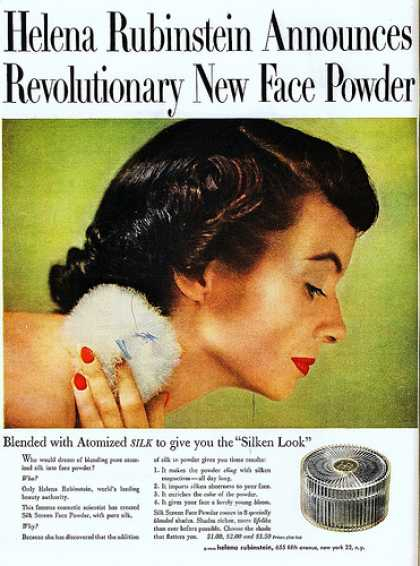
1949 Dab On Powder with a Puff
Tip: A fluffy face puff makes a difference. Don’t use compressed powder with a flat pad for early 1940s looks. Pan-cake compressed makeup came out in the mid 1940s with big success. To women who could afford it, it provided more coverage applied in less time. Just remember to always brush up, never down.
1940s Blush
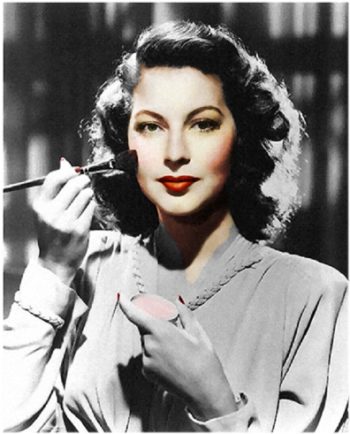
Rouge (blush) Applied to the Center and Brushed Up and Out to the Cheekbones
Blushes (called rouge at the time) were used sparingly and weren’t available in many shades. They were mostly pinkish shades of peach and coral or raspberry for bronze skintones. Moist rouge (cream) was used often to give a natural color and was blended into the foundation. Compressed powders were also brushed lightly on the cheekbones to give a natural rosy look. Rouge isn’t completely necessary to the ’40s look, and going without it will still achieve the right affect.
Tip: Rouge cream is best, but if you can’t find any, use a light matte lipstick instead. Apply to fingers then dab and dot on checks and rub in till blended.
Rouge cream or liquid rouge are often found at theatrical costume makeup stores. Some are available in common brands, too – see these on Amazon.
1940s Eyebrows
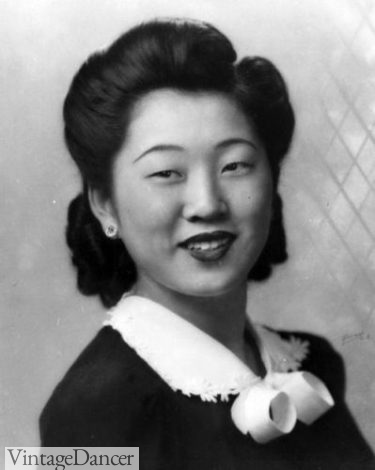
Beautifully Arched Eyebrows Were a Carryover From the 1930s
Eyebrows that were thin and arched continued to be worn in the early years, a carry-over from the 1930s, as well as in the late 1940s, leading into the contoured faces of the 1940s. Eyebrows were worn fairly natural-looking. Arches were well-groomed, but eyebrows weren’t tweezed to be extremely thin–only the stray hairs were removed to create an even, natural arch. They were further defined with eyebrow pencils that were slightly darker than the hair–a line was drawn at the top of the brow and the hairs below were left soft. Most women didn’t even use an eyebrow pencil, instead just dabbing on a little petroleum jelly to smooth the hairs into an arch. Personally, I like this look best for day wear.
- Early 40s, thin shaped eyebrows
- 1942 full arched eyebrows
- 1943 even arched eyebrows
- 1944 Thin Eyebrows Heavier Towards the Nose
- 1947, Full Eyebrows Tapered to the Edge
1940s Eye Makeup
Very little makeup was used on the eyes. During the day, most women wore a light coating of dark brown or black mascara. Some only used Vaseline brushed on the lashes. Mascara came in liquid, paste, or cake with a small lash brush. Adding a drop of water or spit to cake makeup gave it a thick build up. 1940s eye lashes were a bit on the heavy side compared to today’s look. Mascara was applied to both the upper and lower lashes.
Eye shadows could also be worn, but in very neutral colors, and usually only for evening looks. Eye shadows should match the eye color (not compliment it like we do today). Blue-eyed gals should use blue-grey shadow, green eyes used grey shadow and brown shadow was used on hazel, brown, or black eyes.
For evenings, eye shadow colors were sometimes matched to the dress, but often silver or gold was added to a regularly used shade. Eye shadow was worn in a single color (no smoky eyes or contouring here!) from the lash line all the way to the brow and blended for an evening look, or just on the top eyelid for daywear. Eyeliner wasn’t used at all until the very end of the 1940s, and then only applied to the top lash line. Eyeliner was believed to be too “fake” looking in most cases.
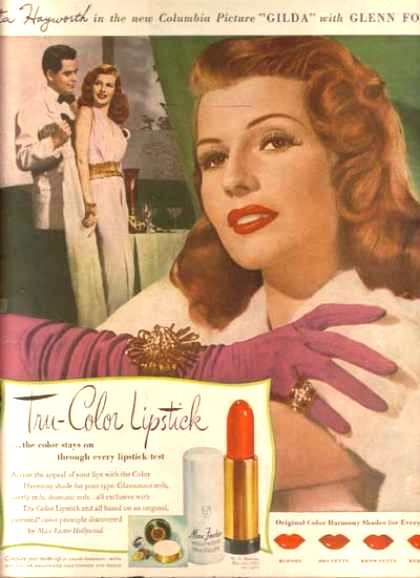
1946 Evening Makeup with Gray-ish Eyeshadow
1940s Lipsticks
The lips are the most important part of the ’40s face. Lipstick was thought to keep women’s spirits up during wartime. Lipstick was red, red and … red! Shades could be bluish or orange-y and everywhere in between, but lipstick was always red and always worn. In the fall, shades became a little darker, and were a little bit lighter in the spring. Steer clear of bright pinks though – they weren’t worn until the ‘50s.
Lipstick was generally completely matte – women were told to moisturize lips before applying lipstick, as well as adding a dab of oil on top of the lips if the color was too bland. They also blotted lips with a tissue after each lipstick application. By 1948, lipstick pencils had appeared and were being used to perfectly outline the mouth before lipstick was applied.
- 1943 Vibrant Red Lipstick was a Must!
- Tangee Lipstick Colors Ranged from Deep Red to Pinnk
- 1949, Full Red Lips Were for Every Skin Tone
Women tried to plump up their pout using lipstick if their mouth was ‘too thin.’ They went for an even look – lips should be the same size on top and bottom. This plump look was called the Hunters Bow lip, coined by Max Factor, and made popular by actress Joan Crawford. For thin lipped women, over-drawing the lip line was needed to achieve the right shape. Lip liners certainly helped with this in the late ’40s. Actresses Lauren Bacall and Ingrid Bergman didn’t bother to overdraw their naturally thin lips. They preferred the natural beauty look, as did most women in the 1940s.
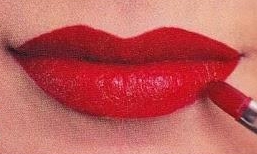
1940s Overdrawn Red Lips, Full on Top and Bottom
Tip: Start your draw line either with pencil or pointed lipstick at the peak of your cupid’s bow and draw outward to the mouth corners. Fill in the top lip with lipstick. Rub your top and bottom lip together to transfer the color. Touch up the bottom lip if its not even with the top.
1940s Fingernail Polish
Fingernails were always neatly trimmed and filed into long oval shapes. Nails were kept slightly shorter during wartime work for safety. Cuticles were also always kept immaculate, trimmed, and moisturized. Nails were almost always painted in various shades of red, although pink, coral, mauve, rose and burgundy were also popular colors. Nail polish colors often came in a set with matching lipstick.
A clear coat topped all nail polish for durability. One fingernail fad was to leave the half moon white spot at the base unpainted – this was a classic fingernail style of the 1920s to 1940s. Seeing a manicurist was a frequent expense for women throughout the decade.
Tip: An easy way to create an even half moon shape on your nails is to use stick on hole paper reinforcements. Apply the labels to the base of your nails. If the top of the inside hole is just touching your cuticles, then the polish lines will be right where you want them. Apply polish. Remove labels after one minute but before the polish is completely dried. Use a white polish if your nails are dull. Apply clear coat to finish. See detailed directions here.
1940s Makeup Products to Buy Today
Today it won’t take much makeup to finish off your ’40s look. Just paint your nails red, put on plenty of face powder and black mascara, define those brows, put on a flattering shade of red lipstick, and you’re good to go! It is not nearly as complicated as most online tutorials show you.
TIP: Purchasing modern makeup to create a 1940s look is not easy. Most modern colors are shiny, glittery, bright, and otherwise unsuitable for the natural ’40s look. You will want to find makeup that is pure matte – no shine.
Revlon makes a good matte line, and some of the newer organic makeup lines also have good choices. Max Factor and Elizabeth Arden were original 1940s brands and thus still have a few colors and products in their modern line (like Pan Cake powder). My personal favorite pure red lipstick is L’Oreal Infallible Le Rouge Lipstick #308c
Besame is another line that recreates vintage makeup colors and cosmetic cases from original formulas (highly recommended!). They have a guide to which of their makeup works for different eras here.
Finding the right color and makeup brand for you will be trial and error.
For my own 40s makeup I tend to choose very light applications of powders, blush, and mascara with a red or pinkish red lipstick. If I was going for an evening or pinup look I would do heavier applications.
- Very Light 40s Makeup
- A Bold Red Lipstick is All You Need for the 40s
More 1940s Makeup Guides
To get more tutorials, I would normally suggest turning to a book or website on 1940s makeup. However, in my opinion, there are few quality sources for the natural everyday women of the ’40s. Most online videos and tutorials lean on the modern or “pin up” side of makeup and use a boat load of extra makeup products and tools never known in the 1940s. Use them as a suggestion, but stick to the style explained here and you will be glamorous in no time.
Here are a few sources I DO recommend:
http://hair-and-makeup-artist.com/womens-1940s-makeup/ – More 1940s Makeup history
Retro Makeup: Techniques for Applying the Vintage Look by Lauren Rennells is a great book to have on hand. The looks are a bit more movie star than daywear, but the modern techniques are still helpful. I love her Vintage Hairstyling book too.
Makeup & Beauty – A 1940s Guide – This original beauty book from the 1940s is the one resource I highly recommend when you are ready to take your makeup application to the next level. The book covers more details about choosing colors, application tips and tools, and my favorite: how to apply makeup for my specific face shape.
Read More
- Authentic 1950s Makeup Tutorial
- Natural 1930s Makeup Guide
- 1940s Women’s Hairstyles
- Women’s 1940s Hats History
- 1940s Shoe Styles for Women
1940s Makeup and Beauty Products
Debbie Sessions has been teaching fashion history and helping people dress for vintage themed events since 2009. She has turned a hobby into VintageDancer.com with hundreds of well researched articles and hand picked links to vintage inspired clothing online. She aims to make dressing accurately (or not) an affordable option for all. Oh, and she dances too.
